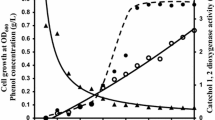Abstract
Pseudomonas putida strain BNF1 was isolated to degrade aromatic hydrocarbons efficiently and use phenol as a main carbon and energy source to support its growth. Catechol 2,3-dioxygenase was found to be the responsible key enzyme for the biodegradation of aromatic hydrocarbons. Catechol 2,3-dioxygenase gene was cloned from plasmid DNA of P. putida strain BNF1. The nucleotide base sequence of a 924 bp segment encoding the catechol 2,3-dioxygenase (C23O) was determined. This segment showed an open reading frame, which encoded a polypeptide of 307 amino acids. C23O gene was inserted into NotI-cut transposon vector pUT/mini-Tn5 (Kmr) to get a novel transposon vector pUT/mini-Tn5-C23O. With the helper plasmid PRK2013, the transposon vector pUT/mini-Tn5-C23O was introduced into one alkanes degrading strain Acinetobacter sp. BS3 by triparental conjugation, and then the C23O gene was integrated into the chromosome of Acinetobacter sp. BS3. And the recombinant BS3-C23O, which could express catechol 2,3-dioxygenase protein, was obtained. The recombinant BS3-C23O was able to degrade various aromatic hydrocarbons and n-alkanes. Broad substrate specificity, high enzyme activity, and the favorable stability suggest that the BS3-C23O was a potential candidate used for the biodegradation of crude oil.






Similar content being viewed by others
References
Di Martino C, Lópezand NIR, Iustman LJ (2002) Isolation and characterization of benzene, toluene and xylene degrading Pseudomonas sp. selected as candidates for bioremediation. Int Biodeter Biodegrad 67:15–20
Lindstrom JE, Braddock JF (2002) Biodegradation of petroleum hydrocarbons at low temperature in the presence of dispersant Corexit 9500. Mar Pollut Bul 44:739–747
Pepi M, Cesaro A, Liut G, Baldi F (2005) An antarctic psychrotrophic bacterium Halomonas sp. ANT-3b, growing on n-hexadecane, produces a new emulsifying glycolipid. FEMS Microbiol Ecol 53:157–166
Aldrett S, Bonner JS, Mills MA, Autenrieth RL, Stephens FL (1997) Microbial degradation of crude oil in marine environments tested in a flask experiment. Water Res 31:2840–2848
Zídková L, Szőköl J, Rucká L, Pátek M, Nešvera J (2012) Biodegradation of phenol using recombinant plasmid-carrying ropolis strains Rhodococcus eryth. Int Biodeter Biodegrad 1–6. doi:10.1016/j.ibiod.2012.05.017
Ibrahim MK (2003) Cloning and nucleotide sequence of catechol 2,3-dioxygenase gene from the naphthalene-degrading pseudomonas putida NA3. Int J Agric Biol 5:423–427
Han EM, Jung YH, On HY et al (1997) Tn5 tagging of the phenol-degrading gene on the chromosome of Pseudomonas putida. Mol Cells 7:40–44
Harayama S, Rekik M (1989) Bacterial aromatic ring-cleavage enzyme are classified into two different gene families. J Biol Chem 263:15328–15333
Diaz E (2004) Bacterial degradation of aromatic pollutants: a paradigm of metabolic versatility. Int Microbiol 7:173–180
Zahir ZA, Akhtar SS, Ahmad M, Nadeem SM, Saifullah (2012) Comparative effectiveness of Enterobacter aerogenes and Pseudomonas fluorescens for mitigating the depressing effect of brackish water on maize. Int J Agric Biol 14:337–344
Sambrook J, Fritisch EF, Maniatis T (1989) Molecular cloning: a laboratory manual, 2nd edn. Cold Spring Harbor, New York
Meyer S, Moser R, Neef A, Stahl U, Kämpfer P (1999) Differential detection of key enzymes of polyaromatic-hydrocarbon-degrading bacteria using PCR and gene probes. Microbiol 145:1731–1741
Mezei LM, Storts DR (1994) Purification of PCR products. In: Griffin HG, Griffin AM (eds) PCR technology: current innovations. CRC, Boca Raton, p 21
Heinaru E, Truu J, Stottmeister U, Heinaru A (2000) Three types of phenol and p-cresol catabolism in phenol- and p-cresol-degrading bacteria isolated from river water continuously polluted with phenolic compounds. FEMS Microbiol Ecol 31:195–205
Bradford MM (1976) A rapid and sensitive method for the quantitation of microgram quantities of protein utilizing the principle of protein-dye binding. Anal Biochem 72:248–254
Nakai C, Kagamiyama H, Nozaki M et al (1983) Complete nucleotide sequence of the metapyrocatechase gene on the TOI plasmid of Pseudomonas putida mt-2. J Biol Chem 258:2923–2928
Noh SJ, Kim Y, Min KH, Karegoudar TB, Kim CK (2000) Cloning and nucleotide sequence analysis of xylE gene responsible for meta-cleavage of 4-chlorocatechol from Pseudomonas sp. S-47. Mol Cells 10:475–479
Acknowledgments
This work was financially supported by the Microbial Engineering Laboratory of Northwestern University and Technical Innovation Program of Xi’an of China (CX09017).
Conflict of interest
The authors declare that there are no conflicts of interest.
Author information
Authors and Affiliations
Corresponding author
Rights and permissions
About this article
Cite this article
Xie, Y., Yu, F., Wang, Q. et al. Cloning of Catechol 2,3-Dioxygenase Gene and Construction of a Stable Genetically Engineered Strain for Degrading Crude Oil. Indian J Microbiol 54, 59–64 (2014). https://doi.org/10.1007/s12088-013-0411-2
Received:
Accepted:
Published:
Issue Date:
DOI: https://doi.org/10.1007/s12088-013-0411-2




